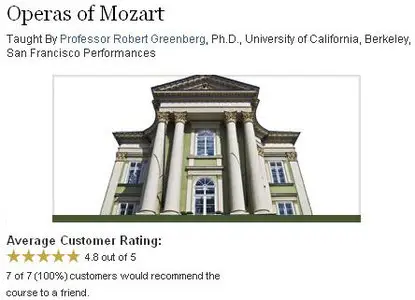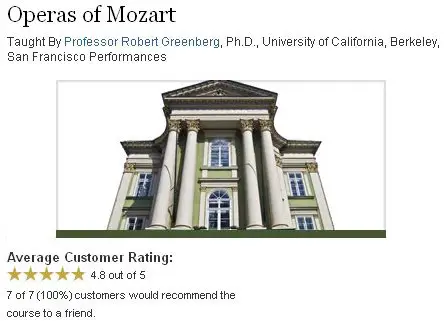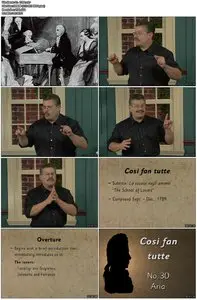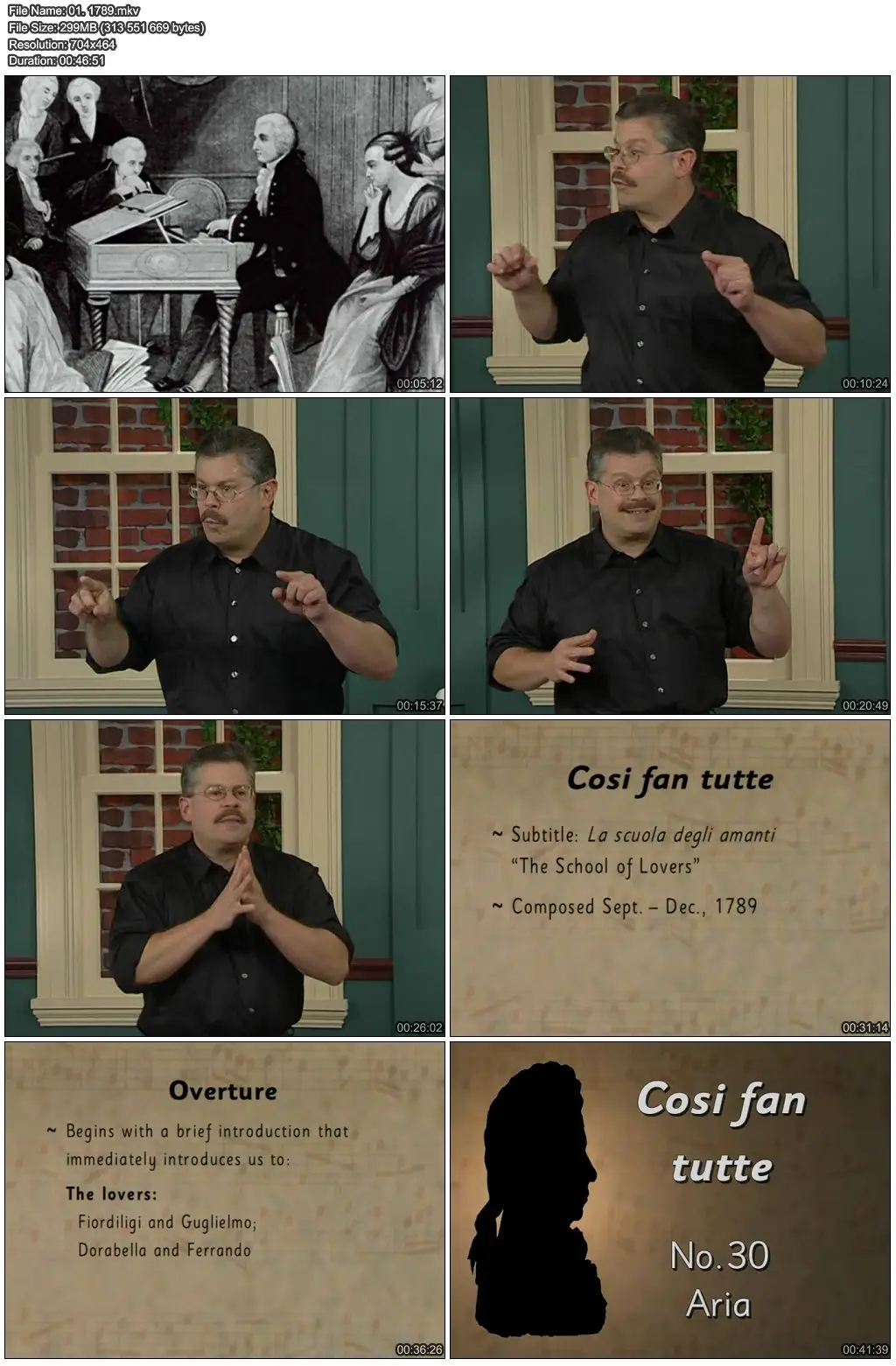TTC Video - Operas of Mozart
English | MKV | AVC | 704x464 | 29.97 fps | AC3, 192 kbps | ~24x45 min | 7.02 GB
English | MKV | AVC | 704x464 | 29.97 fps | AC3, 192 kbps | ~24x45 min | 7.02 GB
By December 1791, Wolfgang Amadeus Mozart had written the defining compositions in every available musical genre of his time: symphony, chamber music, masses, and—above all—opera.
Opera was the prestige genre of the time, and Mozart loved it dearly and counted on it heavily for personal, professional, artistic, and financial reasons. Just the thought of opera, as Mozart wrote, made him "beside myself at once."
The world of the operatic stage spoke deeply to his primal instinct for play, his taste for fantasy, and his restless creative imagination.
Mozart's operas vie with each other to be considered among the greatest achievements of human artistic striving: Idomeneo, The Abduction from the Harem, The Marriage of Figaro, Così fan tutte, Don Giovanni, The Magic Flute.
On September 30, 1791, the last of his masterpieces, The Magic Flute, had premiered in Vienna. Ten weeks later, on December 5, 1791, at the age of 35—when most of us are still hoping for one great accomplishment in our lives—Mozart was dead.
What Did Mozart Do? And How Did He Do It?
In this course with Professor Robert Greenberg, we are summoned to understand more fully the height of Mozart's operatic achievement by analyzing two masterpieces closely. The course also invites us to fathom the enigma of Mozart's meteoric genius by studying his career and development.
Professor Greenberg is not an idolator—he reminds us that Mozart was a man, a human, working to make a name and a living. Professor Greenberg shows that Mozart was an "irreverent revolutionary" who did not worship the past. Accordingly, says Professor Greenberg, "This course is somewhat different from what you might expect. It brings Mozart's art refreshingly down to earth. It does not trivialize opera, nor does it put it on a pedestal."
The structure of the course is somewhat unusual. The 24 lectures are in three parts of eight lectures each. The first and third parts concentrate your attention on two works of surpassing beauty and accomplishment, Così fan tutte and The Magic Flute.
The middle eight lectures of the course study Mozart's early life and development from the first opera he wrote (when he was 11 years old) to Don Giovanni, completed when he was 31.
A Brief Tour of the Course: A Genius in Three Acts
PART I: Così fan tutte
In his early years in Vienna (1781–1785), Mozart enjoyed considerable success as a composer and performer. By 1785, when he was 29, he was among the highest-paid musicians in Europe, and he and his wife Constanze lived very well.
From 1786 onwards, however, he received fewer commissions and opportunities to perform. This was in part because he fell out of favor with any number of Viennese aristocrats as a result of the pointed satire in The Marriage of Figaro of 1786 and partly because of a war with the Ottoman Empire that by 1788 brought austerity to Vienna.
In 1789, Mozart and master librettist Lorenzo da Ponte (a Jewish-born, Italian ex-priest) wrote Così fan tutte (All Women Behave Like This). Imperial court composer Antonio Salieri had rejected this project because the libretto dealt with sexual infidelity. By then, both Wolfgang and Constanze had been coping for some time with illness, financial anxieties, family tragedy, and distrust and strife within their marriage.
Così fan tutte is one of three operas—the others are The Marriage of Figaro and Don Giovanni—that Mozart wrote with da Ponte. Their collaboration can rightly be considered one of the greatest in the history of opera. Così is a masterpiece of comic opera—opera buffa—and this study of it will establish an operatic vocabulary with which to measure and study Mozart's other operas.
PART II: Early Life, Singspiel, and Mastery of the Form
Mozart had a lifelong love of the opera, having written his first opera-like composition by the age of 11. A few weeks after that he composed the music for his first opera, Apollo et Hyacinthus.
The operatic genre favored by the aristocracy was a type of opera called "heroic" or "serious" opera (opera seria). In 1780, Mozart, then 24, received a commission from Munich to write the opera seria Idomeneo, rè di Creta, based on a character from Homeric myth.
Idomeneo premiered on January 29, 1781. It is generally considered the greatest opera seria ever written. Its dramatic momentum sweeps away the traditional rituals of opera seria; the characters are given depth and substance that transcend their archetypes, and Mozart's compositional technique reaches an unprecedented level of mastery.
In 1781, Mozart's unhappiness in the service of the Archbishop of Salzburg brought about his dismissal.
His musical genius quickly found an appreciative audience in the Habsburg capital of Vienna, where he was invited to write an opera for the new Imperial German Theater.
The result was The Abduction from the Harem of 1782. It was, in Mozart's lifetime, his most popular work.
After The Abduction, Mozart did not complete and produce another opera until 1786—The Marriage of Figaro. Lorenzo da Ponte wrote the libretto for what would be his and Mozart's first and greatest masterwork.
The next year, Mozart collaborated again with da Ponte, and Don Giovanni was the result. The libretto recounts the ancient morality tale of Don Juan, whose lack of conscience and restraint doom him.
You hear how Mozart imbued Don Giovanni with an extraordinary degree of momentum and dramatic interaction, all the while using the orchestra to knit together and give context to the vocal parts. The second act finale is one of the greatest conclusions in all of opera.
PART III: The Magic Flute
In 1791, Mozart and fellow Mason Emanuel Schikaneder collaborated on a singspiel that premiered on September 30, 1791.
The Magic Flute was immensely popular, and history has shown it to be one of the most successful operas ever written.
Its libretto, on the surface, is a farrago of obscure Masonic lore that has been injected into a standard boy-meets-girl fairy tale plot, set against a faux-Egyptian background, and relieved by the low-comedy antics of a character resembling an 18th-century Austrian Big Bird.
But when Mozart took hold of the material, the result was something transcendent, not just because the music was superb but because Mozart used it to illustrate character, to reveal emotion, to propel action, and to weave a world on stage as fully realized and fascinatingly imagined as anything in the dramatic repertoire.
Ironically, with money finally coming in, Mozart died just 10 weeks after The Magic Flute's premiere.
Works you’ll hear in the lectures are excerpted from:
Apollo et Hyacinthus, K. 38 (1767)
Bastien und Bastienne, K. 50 [K. 46b] (1768)
La finta semplice, K. 51 [K 46a] (1769)
Lucio Silla, K. 135 (1772)
La finta giardiniera, K. 196 (1775)
Il rè pastore, K. 208 (1775)
Idomeneo, rè di Creta, K. 366 (1781)
The Abduction from the Harem, K. 384 (1782)
The Marriage of Figaro, K. 492 (1786)
Don Giovanni, K. 527 (1787)
Così fan tutte, K. 588 (1789)
The Magic Flute, K. 620 (1791)
On September 30, 1791, the last of his masterpieces, The Magic Flute, had premiered in Vienna. Ten weeks later, on December 5, 1791, at the age of 35—when most of us are still hoping for one great accomplishment in our lives—Mozart was dead.
What Did Mozart Do? And How Did He Do It?
In this course with Professor Robert Greenberg, we are summoned to understand more fully the height of Mozart's operatic achievement by analyzing two masterpieces closely. The course also invites us to fathom the enigma of Mozart's meteoric genius by studying his career and development.
Professor Greenberg is not an idolator—he reminds us that Mozart was a man, a human, working to make a name and a living. Professor Greenberg shows that Mozart was an "irreverent revolutionary" who did not worship the past. Accordingly, says Professor Greenberg, "This course is somewhat different from what you might expect. It brings Mozart's art refreshingly down to earth. It does not trivialize opera, nor does it put it on a pedestal."
The structure of the course is somewhat unusual. The 24 lectures are in three parts of eight lectures each. The first and third parts concentrate your attention on two works of surpassing beauty and accomplishment, Così fan tutte and The Magic Flute.
The middle eight lectures of the course study Mozart's early life and development from the first opera he wrote (when he was 11 years old) to Don Giovanni, completed when he was 31.
A Brief Tour of the Course: A Genius in Three Acts
PART I: Così fan tutte
In his early years in Vienna (1781–1785), Mozart enjoyed considerable success as a composer and performer. By 1785, when he was 29, he was among the highest-paid musicians in Europe, and he and his wife Constanze lived very well.
From 1786 onwards, however, he received fewer commissions and opportunities to perform. This was in part because he fell out of favor with any number of Viennese aristocrats as a result of the pointed satire in The Marriage of Figaro of 1786 and partly because of a war with the Ottoman Empire that by 1788 brought austerity to Vienna.
In 1789, Mozart and master librettist Lorenzo da Ponte (a Jewish-born, Italian ex-priest) wrote Così fan tutte (All Women Behave Like This). Imperial court composer Antonio Salieri had rejected this project because the libretto dealt with sexual infidelity. By then, both Wolfgang and Constanze had been coping for some time with illness, financial anxieties, family tragedy, and distrust and strife within their marriage.
Così fan tutte is one of three operas—the others are The Marriage of Figaro and Don Giovanni—that Mozart wrote with da Ponte. Their collaboration can rightly be considered one of the greatest in the history of opera. Così is a masterpiece of comic opera—opera buffa—and this study of it will establish an operatic vocabulary with which to measure and study Mozart's other operas.
PART II: Early Life, Singspiel, and Mastery of the Form
Mozart had a lifelong love of the opera, having written his first opera-like composition by the age of 11. A few weeks after that he composed the music for his first opera, Apollo et Hyacinthus.
The operatic genre favored by the aristocracy was a type of opera called "heroic" or "serious" opera (opera seria). In 1780, Mozart, then 24, received a commission from Munich to write the opera seria Idomeneo, rè di Creta, based on a character from Homeric myth.
Idomeneo premiered on January 29, 1781. It is generally considered the greatest opera seria ever written. Its dramatic momentum sweeps away the traditional rituals of opera seria; the characters are given depth and substance that transcend their archetypes, and Mozart's compositional technique reaches an unprecedented level of mastery.
In 1781, Mozart's unhappiness in the service of the Archbishop of Salzburg brought about his dismissal.
His musical genius quickly found an appreciative audience in the Habsburg capital of Vienna, where he was invited to write an opera for the new Imperial German Theater.
The result was The Abduction from the Harem of 1782. It was, in Mozart's lifetime, his most popular work.
After The Abduction, Mozart did not complete and produce another opera until 1786—The Marriage of Figaro. Lorenzo da Ponte wrote the libretto for what would be his and Mozart's first and greatest masterwork.
The next year, Mozart collaborated again with da Ponte, and Don Giovanni was the result. The libretto recounts the ancient morality tale of Don Juan, whose lack of conscience and restraint doom him.
You hear how Mozart imbued Don Giovanni with an extraordinary degree of momentum and dramatic interaction, all the while using the orchestra to knit together and give context to the vocal parts. The second act finale is one of the greatest conclusions in all of opera.
PART III: The Magic Flute
In 1791, Mozart and fellow Mason Emanuel Schikaneder collaborated on a singspiel that premiered on September 30, 1791.
The Magic Flute was immensely popular, and history has shown it to be one of the most successful operas ever written.
Its libretto, on the surface, is a farrago of obscure Masonic lore that has been injected into a standard boy-meets-girl fairy tale plot, set against a faux-Egyptian background, and relieved by the low-comedy antics of a character resembling an 18th-century Austrian Big Bird.
But when Mozart took hold of the material, the result was something transcendent, not just because the music was superb but because Mozart used it to illustrate character, to reveal emotion, to propel action, and to weave a world on stage as fully realized and fascinatingly imagined as anything in the dramatic repertoire.
Ironically, with money finally coming in, Mozart died just 10 weeks after The Magic Flute's premiere.
Works you’ll hear in the lectures are excerpted from:
Apollo et Hyacinthus, K. 38 (1767)
Bastien und Bastienne, K. 50 [K. 46b] (1768)
La finta semplice, K. 51 [K 46a] (1769)
Lucio Silla, K. 135 (1772)
La finta giardiniera, K. 196 (1775)
Il rè pastore, K. 208 (1775)
Idomeneo, rè di Creta, K. 366 (1781)
The Abduction from the Harem, K. 384 (1782)
The Marriage of Figaro, K. 492 (1786)
Don Giovanni, K. 527 (1787)
Così fan tutte, K. 588 (1789)
The Magic Flute, K. 620 (1791)
1789
Così fan tutte, Part One
Così fan tutte, Part Two
Così fan tutte, Part Three
Così fan tutte, Part Four
Così fan tutte, Part Five
Così fan tutte, Part Six
Così fan tutte, Part Seven
The First Works
The Italian Apprenticeship
The Professional, Part One
The Professional, Part Two
Vienna and Abduction
Salieri, Da Ponte and The Marriage of Figaro
Don Giovanni, Part One
Don Giovanni, Part Two
Mozart, Masonry and The Magic Flute
The Magic Flute, Part Two
The Magic Flute, Part Three
The Magic Flute, Part Four
The Magic Flute, Part Five
The Magic Flute, Part Six
The Magic Flute, Part Seven
The Magic Flute, Part Eight
Professor: Robert Greenberg









